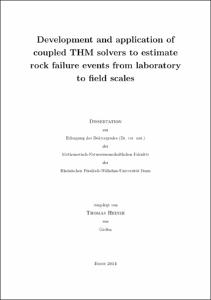Development and application of coupled THM solvers to estimate rock failure events from laboratory to field scales

Development and application of coupled THM solvers to estimate rock failure events from laboratory to field scales

| dc.contributor.advisor | Miller, Stephen A. | |
| dc.contributor.author | Heinze, Thomas | |
| dc.date.accessioned | 2020-04-21T07:10:30Z | |
| dc.date.available | 2020-04-21T07:10:30Z | |
| dc.date.issued | 14.07.2015 | |
| dc.identifier.uri | https://hdl.handle.net/20.500.11811/6492 | |
| dc.description.abstract | In this thesis I present a theoretical and numerical model to simulate complex fluid-rock interactions with a poro- elasto- plastic rheology, multi- phase flow and heat transport (THM- model). Goal of this work is to improve existing approaches fundamentally by elaborating a better, dynamic rheological model as well as developing tools to improve the comparison between simulation and observations on field and laboratory scale. This work contains the derivation and implementation of a two- surface plastic damage model, a method to detect a numerical analog for acoustic emissions in rock samples and a simulation of earthquake swarms in western bohemia. The developed damage model outnumbers existing approaches in terms of a realistic reproduction of experimental measurements and will be usefull for future simulations of drained and undrained rock deformations. Especially if the rock is subjected to cyclic load or pore pressure, damage effects are essential. In fluid- rock systems this can often be the case due to temporarily increasing and decreasing fluid pressure. Reoccurring, fluid- driven earthquake swarms and stimulation of geothermal fields with hydrofracturing are examples for this. Acoustic emissions (AE) and (micro-) seismic events contain important information on a very local range which can not be resolved by other measurement techniques. On the other hand, there is no physical property directly related to AE. In this work I present a straightforward mechanism to obtain a proxy for acoustic emissions during a numerical simulation which agrees very well with laboratory measurements. The same mechanism can be extended to field scale for detecting and localizing earthquakes. I present an application of this method to the 2008 earthquake swarm in West- Bohemia (Czech Republic). Using the developed method I am abel reproduce the localization, temporal evolution and magnitude distribution of the original earthquake catalog. The projects examined in this thesis are suitable over a wide range of use cases. Industrial applications like geothermal energy or CO2 sequestration can profit from presented methods and natural phenomena like earthquake swarms can be examined in more detail. Several aspects of this work are not even limited to geoscience and can be helpful in other subjects like material science and civil engineering. To validate and enable a reasonable usage of the theoretical model a numerical implementation is presented for all developed models. | en |
| dc.description.abstract | In dieser Arbeit präsentiere ich ein theoretisches und numerisches Model zur Beschreibung komplexer Wechselwirkungen zwischen Gestein und Flüssigkeiten. Ich verwende dabei eine poro- elasto- plastische Rheologie, Mehr- Phasen- Fluide und Wärmetransport (THM- Model). Ziel der Arbeit ist es existierende Modelle zu verbessern, indem ein vollständiges, dynamisches rheologisches Model ausgearbeitet wird und Methoden entwickelt werden, um einen besseren Vergleich zwischen Simulation und Feld- und Labormessungen zu ermöglichen. Diese Arbeit beinhaltet die Herleitung eines plastischen Schadensmodel, eine Methode um ein numerisches Analogon für akustische Emissionen in Gesteinsproben zu finden und eine Simulation eines Erdbebenschwarms in West- Böhmen. Ein realistisches Schadensmodel ist besonders dann von Bedeutung, wenn Belastungen zyklisch stattfinden. In Gesteins- Flüssigkeits Systemen kann das vorkommen durch ansteigenden und abnehmenden Fluiddruck. Etwa wiederkehrende, fluid-getriebene Erdbebenschwärme oder die Stimulation eines Gebietes durch Hydrofracturing sind Beispiele dafür. Akustische Emissionen (AE) und (mikro-) seismische Ereignisse geben Informationen über sehr lokale Spannungszustände, die durch andere Messungen nicht zugänglich sind. Gleichzeitig sind jedoch gerade AEs nicht direkt mit einer physikalischen Größe verknüpft. In dieser Arbeit entwickle ich eine Methode um eine physikalische und numerische Entsprechung für diese Emissionen zu finden. Mit Hilfe der gleichen Methode bin ich auch in der Lage die örtlich- zeitliche sowie die Magnituden- Entwicklung des 2008 Erdbebenschwarms in Böhmen zu reproduzieren. Die entwickelten Methoden haben eine Vielzahl an Anwendungen. Sowohl industrieler Art, etwa für geothermische Anlagen oder zur Speicherung von CO2 im Untergrund, als auch zur Beschreibung natürlicher Erscheinungen wie Erdbebenschwärme. Einige Aspekte dieser Arbeit sind nicht auf die Geowissenschaften begrenzt, sondern können auch in verwandten Wissenschaften wie der Materialkunde oder dem Bauingenieurwesen Verwendung finden. Um die entwickelten Methoden zu testen und eine realistische Anwendung zu ermöglichen sind alle entwickelten Methoden in ein numerisches Model eingebettet. | en |
| dc.language.iso | eng | |
| dc.rights | In Copyright | |
| dc.rights.uri | http://rightsstatements.org/vocab/InC/1.0/ | |
| dc.subject | Gesteinsmechanik | |
| dc.subject | Akustische Emissionen | |
| dc.subject | Gesteinsbruch | |
| dc.subject | Numerik | |
| dc.subject | Modellierung | |
| dc.subject | rock mechanics | |
| dc.subject | acoustic emissions | |
| dc.subject | rock failure | |
| dc.subject | numerics | |
| dc.subject | Modeling | |
| dc.subject.ddc | 550 Geowissenschaften | |
| dc.title | Development and application of coupled THM solvers to estimate rock failure events from laboratory to field scales | |
| dc.type | Dissertation oder Habilitation | |
| dc.publisher.name | Universitäts- und Landesbibliothek Bonn | |
| dc.publisher.location | Bonn | |
| dc.rights.accessRights | openAccess | |
| dc.identifier.urn | https://nbn-resolving.org/urn:nbn:de:hbz:5n-40500 | |
| ulbbn.pubtype | Erstveröffentlichung | |
| ulbbnediss.affiliation.name | Rheinische Friedrich-Wilhelms-Universität Bonn | |
| ulbbnediss.affiliation.location | Bonn | |
| ulbbnediss.thesis.level | Dissertation | |
| ulbbnediss.dissID | 4050 | |
| ulbbnediss.date.accepted | 30.06.2015 | |
| ulbbnediss.institute | Mathematisch-Naturwissenschaftliche Fakultät : Fachgruppe Erdwissenschaften / Steinmann-Institut für Geologie, Mineralogie und Paläontologie | |
| ulbbnediss.fakultaet | Mathematisch-Naturwissenschaftliche Fakultät | |
| dc.contributor.coReferee | Froitzheim, Nikolaus |
Dateien zu dieser Ressource
Das Dokument erscheint in:
-
E-Dissertationen (4305)




